I have chosen to analyze the linguistic landscape (LL) of the area around the metro station Tirso de Molina, in the part of Madrid in which I live. While moving into my apartment, my roommate explained to me that, a few years ago, this would have been a pretty bad neighborhood to live in, but thanks to the influx of tourism in the area, it is becoming a nicer place. What she was saying was that the neighborhood is currently in the process of gentrification. A few years ago, you’d find nothing but locals here, but now, it is not uncommon to see tourists and hear languages other than Spanish. I recently heard people speaking German in a café just down the street from my apartment. When people call out to me on the street to advertise their products or get me to eat in their restaurants, they speak English. This could be because I don’t look the least bit Spanish, but it is nonetheless a testament to the regularity of having English speakers (non-locals) frequent the area. I noticed that this transition makes an interesting impact on the LL of Tirso de Molina: one can observe old signage from before gentrification in the built environment, current signage aimed at only locals, and current signage that is aimed at tourists, reflecting the recent increase in tourism and gentrification.
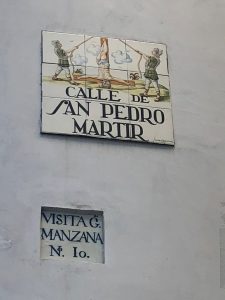
The old signage manifests in the built environment, and these signs appear in Spanish only, catering to locals and other Spanish speakers and not to tourists. A good example of this old signage are the street signs built into the walls of the buildings lining the streets. Take the above street sign for example: it is written in Spanish only, and it uses the Spanish address format. The proper name of the street is easy for tourists to figure out, but the format of the address is completely foreign to a tourist just passing through. The location of the sign also makes them hard to see for tourists (Americans in particular) who are used to having their street signs stick out at them. These subtle attributes of old signage point toward a LL that caters to its residents and other Spanish speakers, not the tourists that have recently been visiting the area.
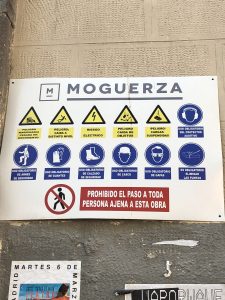
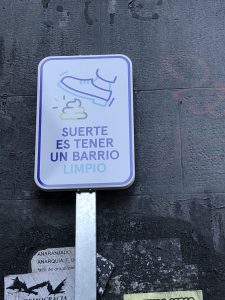
Example 2: Caution Sign Example 3: “Keep the Street Clean” Sign
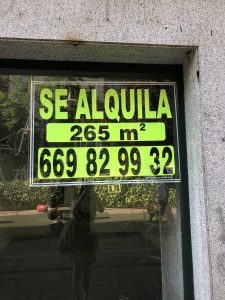 Example 4: “For Rent” Sign
Example 4: “For Rent” Sign
Very common in Tirso de Molina’s LL is new signage aimed at locals only. These signs are mainly informational posters stuck to the sides of buildings. They convey information that tourists would never need, so their printers never bothered to make them bilingual texts. Examine the examples above. Example 2 is to warn people entering a building that it is under construction, Example 3 is to remind people to keep the streets clean, and Example 4 is a sign advertising a space for rent. All of these signs relay important information, but this information would never be something a tourist would be interested in. These signs are aimed at locals, so they appear in Spanish only.
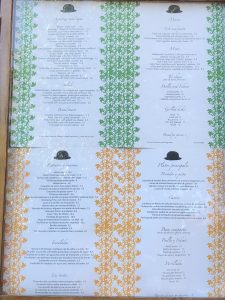

Example 5: Spanish/English Menu Example 6: Spanish/English Advertisement
The final signage category is of those written in English as well as Spanish. These signs manifest in advertisements aimed to draw passersby into their restaurants or shops. These signs have a tendency to be bilingual texts with Spanish and English because the owners of the shops and restaurants recognize that their market has expanded to both locals and tourists. Creating signs in a language that the tourists feel comfortable with, despite whether or not they speak Spanish, makes them feel more comfortable with entering the establishment. The above examples also display how temporary this signage category is. Printed menus and chalkboards can be changed at a moment’s notice, making it easy for these restaurants to make the switch and advertise to locals and tourists alike.
Taking into account practical characteristics of the signs (materials they are made from and their locations, indicating how easy it would be to change them), makes it obvious as to why the signs are in the languages that they are. The signage directed towards locals are in Spanish, but the signs directed toward tourists include both Spanish and English, reflecting the recent influx of tourism in Tirso de Molina.
Works Consulted
Leeman, Jennifer, and Gabriella Modan. “Commodified Language in Chinatown: A Contextualized Approach to Linguistic Landscape.” Journal of Sociolinguistics, vol. 13, no. 3, 2009, pp. 332-362.

I like how you analyze old and new signages and how they aim at locals and tourists. It is an interesting point that English has been a “world language” which almost all countries use, whether for attracting tourists or for building businesses. I am inspired by how you analyze that the position of these signages is related to the targeting readers and gain a deeper understanding of how signs are used.
The analysis of signage uses in Madrid is interesting. English seems to have communicative value in Madrid, as it is used as a tool to attract tourists for commercial purpose. There are three very clear categorizations of the use of signage: the old signage designed local residents, new signage but only for Spanish speakers, and new signage targeting to tourists. I think it is really nice to have the balance of tourism and authenticity in Madrid; while the Spain government is trying to set a tourism-friendly environment, tourists can have very authentic experience of Spanish culture.